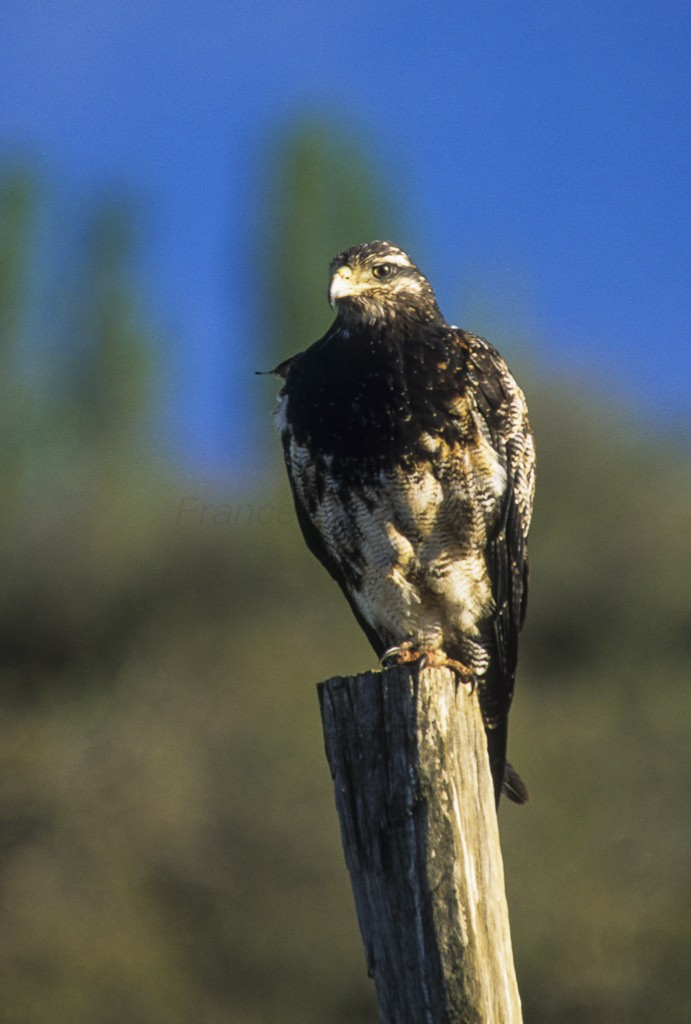Black-chested Buzzard-eagle
A species of Geranoaetus Scientific name : Geranoaetus melanoleucus Genus : Geranoaetus
Black-chested Buzzard-eagle, A species of Geranoaetus
Botanical name: Geranoaetus melanoleucus
Genus: Geranoaetus
Content
Description General Info
 Photo By Francesco Veronesi , used under CC-BY-SA-2.0 /Cropped and compressed from original
Photo By Francesco Veronesi , used under CC-BY-SA-2.0 /Cropped and compressed from original Description
This is a huge eagle-like "buzzard" ("hawk" in American terminology). It has a total length of 62 to 76 cm (24 to 30 in) and a wingspan of 149 to 200 cm (4 ft 11 in to 6 ft 7 in). In the nominate race, males averaged 2.13 kg (4.7 lb) and females averaged 2.75 kg (6.1 lb), with a range between both of 1.67 to 3.17 kg (3.7 to 7.0 lb). In the linearly slightly smaller G. m. australis subspecies, a male weighed 1.7 kg (3.7 lb) and a female weighed 3.2 kg (7.1 lb), indicating the bulk of the two races is roughly the same. It is noted for its bulky, powerful-looking build. It is rather long- and broad-winged and the slightly tapering tail is short by comparison and colored black, with grey tips in fresh plumage. When perched, the wings cover the tail almost completely, giving the bird a unique near-tailess appearance when perched. The adult has a white underside, sometimes with fine blackish stripes; its upperparts are dark grey with a blackish, brownish or bluish hue. The feathers of the neck and the lowest dark feathers of the breast are somewhat elongated. Adults have an ash-grey-and-white zone on the wings, the silvery white seen clearly from afar. The female is distinguished by a reddish-cinnamon hue to the upper- and underwing secondaries and is considerably larger than the male. Among standard measurements, males possess a wing chord of 463 to 555 mm (18.2 to 21.9 in), a tail of 203 to 300 mm (8.0 to 11.8 in), a culmen of 29 to 45 mm (1.1 to 1.8 in) and a tarsus of 95 to 102 mm (3.7 to 4.0 in). In comparison, females have a wing chord of 490 to 566 mm (19.3 to 22.3 in), a tail of 220 to 310 mm (8.7 to 12.2 in), a culmen of 30 to 45 mm (1.2 to 1.8 in) and a tarsus of 89 to 110 mm (3.5 to 4.3 in). The immature plumage is reminiscent of that of the great black hawk (Buteogallus urubitinga). Its upperparts are deep brown, sometimes almost black, and it has no light wing patch. The underside is white or light buff with heavy dark streaks on the breast and dark bars on the belly and thighs. It does not acquire the full adult plumage until 4–5 years old. It is not very vocal, calling usually in flight and when close to the nest. Some calls resemble a wild human laugh, others are a curlew-like whistle. Occasionally flying birds give a high-pitched vocalization "kukukukuku". The black-chested buzzard-eagle is readily identified in flight by its short wedge-shaped tail scarcely protruding from its long, broad wings. It is usually easy to make out the generally white underparts with the dark chest-band and tail if the birds are adult. Yet as this bird is usually encountered in the wild when it soars, you are less likely to see its grey upperparts. 
Size
80 cm
Colors
Black
Gray
White
Life Expectancy
42 years
Nest Placement
Cliff
Feeding Habits
Black-chested Buzzard-eagle, a carnivore, mainly eats mid-sized mammals, notably European rabbits, degus, and occasionally formidable prey like gray foxes. This raptor also consumes birds, large squamates, arthropods, and carrion. Its hunting is beneficial to farmers, and it may contend with Andean condors for carrion.
Habitat
Black-chested Buzzard-eagle's preferred habitat includes mountainous or hilly terrains, often at altitudes of 5,000 to 15,000 feet. It thrives in open areas with sparse vegetation such as shrublands and Nothofagus forests, avoiding humid regions and dense woodlands. Nesting typically occurs on high visibility sites like cliffs and trees. The species seeks environments that support soaring, taking advantage of thermal updrafts and favorable wind conditions.
Dite type
Carnivorous
General Info
Feeding Habits
Bird food type
Species Status
Not globally threatened.